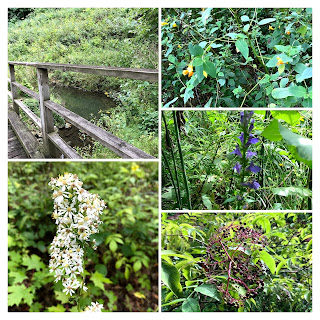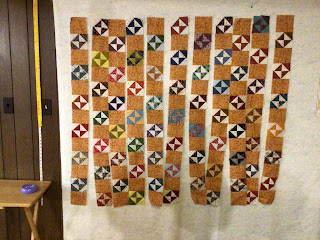Jewel weed, lobelia, elderberries, and an aster.
This is as close as I could get -- I don't know the people who live in the red house.
# # # # # # # #
The church rummage sale (see Friday's post) ended with $5-a-bag on Saturday. I filled a sack with shirts that I'm now deboning, to use Bonnie Hunter's term.Earlier in the month I sent a gallon bag of 1.5" strips to Cathy. I dumped the rest of them out of the bin and sorted them -- longer (10" +) and shorter. (How do they curl up into little balls?) I ironed ALL of them. The long ones became units for my new project based on Bonnie's Bitcoin pattern. (I bought the digital pattern when it was released.)
# # # # # # # #
I'm pleased to report that I finished both parts of my One Monthly Goal for August: the wedding quilt and the guild challenge.
(I've already written about these. Just scroll back to read about them.)
The week's reading included a history, a mystery, and a thriller.
Burrough, Tomlinson, and Stanford skillfully skewer the Heroic Anglo Narrative of the Battle of the Alamo.
Mexico's northern province was considered a backwater outpost of the Spanish and later Mexican empires. In the early 19th century Anglo-Americans from the southeast began settling the cheap (=free; they didn't buy it from the Mexicans) land to raise cotton. Large-scale cotton farming was feasible only with slave labor. The Mexicans were adamantly opposed to slavery. The Mexican army and the Texians (as they called themselves) clashed at Goliad and again at a mission church in San Antonio -- called the Alamo. The battle was brief and disastrous for the Americans and their Tejano allies. (The later battle at San Jacinto was the decisive one.) No sooner had the smoke cleared than the legends began.
Over the decades those legends became enshrined as foundational heroism. Twentieth century battles of the civic kind were fought over how to preserve the site, honor the dead, and interpret the causes and the outcome of the entire war of Texas independence.
It's no spoiler to say that scholarship has revealed the true story to be quite different. As the authors say, "Jim Bowie was a murderer, slaver, and con man. William Barret Travis was a pompous, racist agitator and syphilitic wretch. Davy Crockett was a self-promoting old fool who was a captive to his own myth." They add, "We are seven generations past the Texas Revolt. When Texas celebrate the bicentennial [in 2036] Hispanics will make up the majority of Texans."
Serious history laced with wickedly good humor (the irony of Mexicans in the 1830's fearing hordes of Americans crossing their borders) combine for a great tale.
A team of intrepid senior citizens help the local police solve a murder at their retirement village. In the process they solve a historical murder and uncover international criminal activity. This was such a treat!
I look forward to reading the Club’s second caper which is coming in September.
Peter Swanson writes another suspenseful page-turner. "Life was restarts, one after another, and some were good, and some weren't," contemplates Alice Moody as she and her stepson Harry each seek to discover who killed her husband/his father. "Now" and "Then" chapters describe Harry's actions and Alice's hidden past.
(I read his Eight Perfect Murders a couple of weeks ago.)
Linking up with Oh Scrap! Design Wall Monday Monday Making



















































